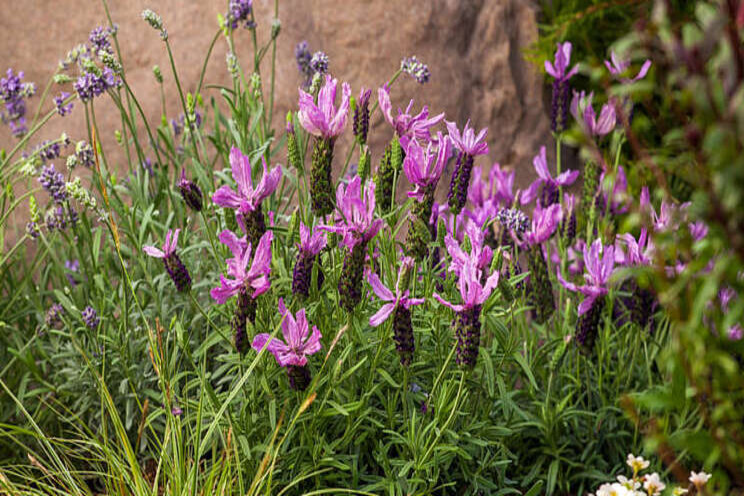Culture report: Lavender Javelin Forte series
Added on 16 November 2020

The stunning Javelin Forte series (Lavandula stoechas) is a vegetatively propagated Spanish lavender with brightly colored sterile flag-like bracts atop the inflorescence. The series includes three colors: Deep Purple, White and Deep Rose. They have an upright habit and grow 14 to 20 inches tall and 12 to 16 inches wide in the garden. The Javelin Forte series is best grown in containers, mass plantings and patio pots for its impactful color, classic scent and performance. It is easy to schedule and grow since it has no vernalization requirement.
PROPAGATION
Stick lavender cuttings immediately upon receipt as they can be very sensitive to shipping conditions and storage. Making them a top priority will help to ensure even, quick rooting. A heavy spray (penetrating the rooting media) using water-soluble K-IBA at 250 to 300 ppm 24 to 48 hours after sticking can speed rooting. Root emergence should be expected 10 to 14 days after sticking in a 105-cell (30 mm) tray or larger. Plugs should be fully rooted in six to seven weeks for a 105-cell tray; add more rooting time for significantly larger plug sizes.
Irrigation. Mist schedules vary depending on light and temperature conditions. Apply minimal mist — just enough moisture to rehydrate the cuttings and keep them from wilting for the first three to four days. Then misting should be significantly reduced once cuttings are fully hydrated. Over misting can lead to uneven callusing and delayed rooting. To help minimize the need to mist and keep the humidity high, tenting of the trays with Reemay cloth has been shown to be extremely successful. Remove the tent once the cuttings are showing roots.
Temperature and light. For the first three weeks in propagation, maintain temperatures of 70-72° F. Once roots are well developed temperatures can be lowered to hold and tone the cuttings. Day temperatures of 66 to 68° F and night temperatures of 64 to 66° F are recommended. Aim for a daily light integral (DLI) of 4 to 6 mols/day for the first two weeks after sticking or until root development occurs. DLI can be increased to 12 mols/day after root formation.
Nutrition and growth control. Begin fertilization at 50-ppm nitrogen when roots become visible. Rates can be increased up to 100-ppm nitrogen after roots become well-developed. Use primarily Cal-Mag Plus (calcium nitrate + magnesium nitrate) fertilizers in propagation to prevent unwanted stretch. Maintain media pH at 5.6 to 6.0 and EC (pour thru) at 1.4 to 2.0 mS/cm. Pinching is recommended to improve branching and bushy plant habit. If necessary, spray B-Nine WSG at 1,500 to 2,000 ppm to control stretch after the cuttings are rooted.

Table 1. Crop time and plants per pot recommendations for finishing Javelin Forte.
FINISHING
Javelin Forte can be finished in 1-quart to 2.5-quart containers with one plant per pot (ppp). Three quart and larger pots need two to three plants per container (Table 1). The crop should finish in 12 to 14 weeks. Transplant directly into the finished container of choice. Place the rooting media slightly above the level of media in the container.

Table 2. Example crop schedule for a 2 ˝-quart container of Javelin Forte.
Temperature and light. An optimal average daily temperature (ADT) for Javelin Forte is 68° F (day 72 to 74° F; night 64 to 66° F). Day extension lighting is beneficial to 14 hours to hasten flowering since Javelin Forte has a facultative long day flowering response. Aim for a DLI of at least 14 to 16 mols/day.
Nutrition and growth control. Fertilize Javelin Forte with 75- to 125-ppm nitrogen for optimal vegetative growth and flower power. Maintain a media pH of 6.1 to 6.5 and EC (pour thru) of 2.3 to 3.2 mS/cm. Media should dry between irrigations alternating between moisture levels 2 and 3. Lavender are Mediterranean plants so don't grow them too wet!
Pinching is recommended one to two times either in propagation or seven to 10 days after transplant to improve branching for a fuller plant habit. If necessary, a B-Nine WSG (daminozide) spray at 2,500 ppm, or a Bonzi (paclobutrazol) spray at 30 ppm can be used to control size and tone the plant. In the hot, humid southern United States, a Sumagic (uniconazole) spray at 3 to 5 ppm may be needed to control growth. If the plants are progressing too quickly for your production schedule and need to be held, a 3- to 5-ppm Bonzi drench at visible bud is effective.
Javelin Forte has no vernalization requirement, but as is the case for many perennial species a short cold treatment for three to four weeks at 50 to 55° F increases flowering uniformity. Bulk plants after transplanting prior to cooling period for best plant fill and habit. Some common pests of lavender are aphids, spider mites and whiteflies. Some common diseases to prevent are Phytophthora, Pythium, Botrytis and Rhizoctonia.
Always read and follow label instructions. Some products may not be registered for sale or use in all states or counties and/or may have state-specific use requirements. Please check with your local Extension service to ensure registration status and proper use. Some or all of the varieties may be protected under one or more of the following: Plant Variety Protection, United States Plant Patents and/or Utility Patents and may not be propagated or reproduced without authorization.
PDF: Culture Report: Lavender Javelin Forte Series
By Mike Fischer, Steffi Hugo and Alican Carlson
Source and Photo Courtesy of Greenhouse Product News
Source: Greenhouse Product News
More news















